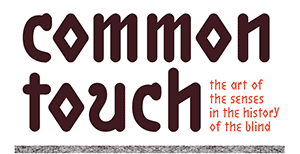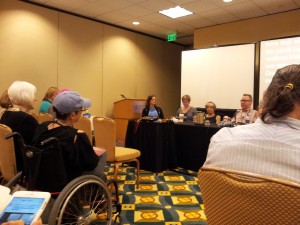My First SDS Conference
A few weeks ago, hundreds of disability studies scholars, advocates, and activists gathered for the 28th Annual Meeting of the Society for Disability Studies, June 10-13, 2015. I was fortunate to be one of the attendees on behalf of the Library Company, a recent institutional member in the Society as a result of the Common Touch project.
I looked forward to my attendance not only for the multiple sessions related to art and disability, but for the experience of a conference that proactively strove to be as universally accessible as possible. Images for power point presentations needed to be verbally described, closed captioning was standard, and large print copies of presentations were available for distribution.
Through my work with Common Touch project partners, I have become increasingly aware that accessibility standards are a benefit to everyone, disabled or not. Case in point for me at the conference was that more than a few times I glanced at the closed captioning for a word or name I missed while taking notes. Nonetheless, even the most concerted efforts for accessibility can sometimes fall a bit short as did the microphone cords for the Q&A’s. As one disabled panelist noted, even the disabled community can be unintentionally unaccommodating as she asked an audience member, who had vertigo, to come to the front to use the mic.
Not surprisingly, insights also abounded from the subject matter of the panel sessions. The panels on art and disability ranged from dialogues about self-representation of disabled persons in art; the nuts and bolts and challenges/ triumphs of organizing professional Disability Arts festivals; and the social/cultural implications of the stories and relationships pervading the materiality, aesthetics, and concepts of works of art by, depicting, or representing persons with disabilities to the benefits of subjective audio descriptions over objective ones.
To conclude my post, instead of expounding on one or two of the themes from the various panels, I thought I would share some of the snippets and jottings from my notes that continue to resonate with me:
Disability as relationships as opposed to a medical versus social model
If disability is framed; disability frames us
Disability as transformation of “normal” body
Privileging disability vs. bridge building through disability in art
An original non-disabled body is non existent
Erika Piola
Associate Curator, Prints and Photographs
Co-Director, VCP at LCP



![[Portrait of Hostetler family of blind musicians]. Mount Pleasant, Penna.: From A. N. Staufer, [ca. 1866]. Black & white photograph. 4 x 2.5 in. Picture shows one woman and three men, seated next to each other, and holding instruments. The woman holds an accordion in her lap and she looks slightly down. To her left is a man, his eyes closed, who holds a viola perpendicular to his lap with one hand and a bow in his other. To his left is a man resting a cello between his legs. He holds a bow across the base of the cello with his right hand. To his left is the last man, his eyes closed, who holds a violin by his left shoulder and a raised bow in in his right hand. The woman, as well as the man who holds a cello, wear glasses. The woman wears a dark-colored corseted dress with long sleeves and a long skirt. The men, who look toward the viewer, are bearded and wear dark-colored suits. [End of description]]](https://commontouch.librarycompany.org/wp-content/uploads/2015/05/hostetler-music-p-2014-60-1-cdv-80x80.jpg)
![Camera Obscura! [United States, ca. 1853]. Printed handbill. 11.5 x 5 in. Picture shows a handbill illustrated with a decorative border. The border is rectangular-shaped and looks like ribbons spiraled around rods with grommets at each of four corners. The document will be described from the top of the page to the bottom. Text reads: Camera Obscura! [new line] There will be an Exhibition [new line] of [new line] Paintings! [new line] Given this [blank] Even[in]g, [new line] at 7 o’clock, [blank] 185[blank] [new line]. In the [blank] [new line] at [blank]. [new line] At which [new line] Prof. W. F. Johnson, [new line] A Colored Gentleman, of the N. Y. In-[new line] stitute for the Blind, will introduce to the citizens [new line] of this vicinity, and the public generally, without [new line] reference to Party or Politics, Fifteen Scenes, illus-[new line] trative of some of the features of the American In- [new line] stitution of Slavery, accompanied by some ap- [new line]propriate odes, “The Slave Mothers’s La-[new line] ment,” “Appeal to Christina,” “Un- [new line] cle Tom’s Religion.” To conclude with ten interesting Changing [new line] Views, magnified, active, and as large as life. [new line] Admission One Shilling. [new line] Children Under 10 years of age sixpence. [new line] [picture of pointed finger] Complimentary to Press and Clergy. [new line] Opinion of the Press.- Mr. Johnson, has been a re- [new line] sident of our village, when at home, for some 20 years, during much of [new line] which time we have been acquainted with him. Blind since his youth, [new line] he has, with untiring perseverance [sic], educated himself. During three [new line] years’ residence in New York Institute for the blind, he made him [new line] self acquainted with the science of Phrenology, under the instruction of [new line] Prof. Fowler. The independence and strength of character exhibited by [new line] Mr. J. in procuring an education, with the privilege of sight denied him, [new line] is worthy of admirati[o]n; and those who know him, stand ready at all [new line] times to attend his lectures and exhibitions. He has an instructive and [new line] entertaining exhibition. – Ithaca Journal. [End of description]](https://commontouch.librarycompany.org/wp-content/uploads/2015/05/smxam1853john-5741-f-2-80x80.jpg)
Leave a Reply
Want to join the discussion?Feel free to contribute!